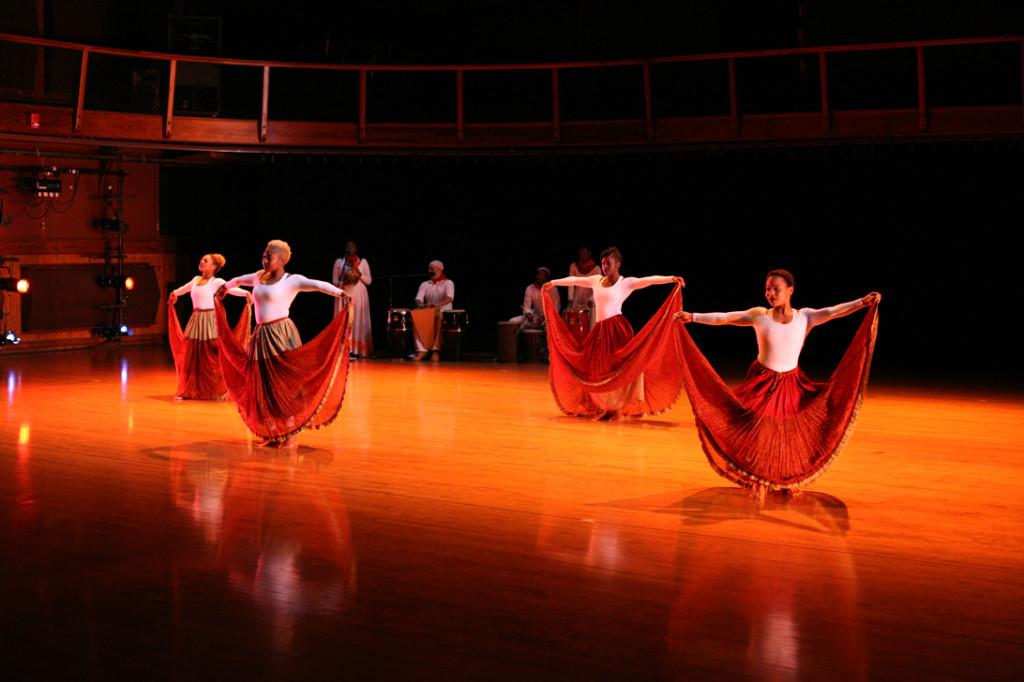Fall Forward Gets Experimental with Mixed Results
During the Saturday performance of Fall Forward, several student dancers open the second act with “Candela” — one of the liveliest performances of the night. Choreographed by Africana Studies Artist-in-Residence Adenike Sharpley, “Candela” was an engaging reprieve from overly experimental first act.
November 15, 2013
Fall Forward, Oberlin’s fall dance showcase which took place in Warner Main on Nov. 7–9, featured a number of Oberlin students performing pieces that drew from a wide array of styles, including ballet and contemporary dance. For the most part, the performances were tight and well-choreographed, but the show did suffer from lengthy lulls of overt experimentalism.
This unconventional spirit was foreshadowed by the show’s opening piece, “Letting the Sweet Out,” in which College sophomore Alana Reibstein danced to a minimally composed piece by Conservatory sophomore Jonah Haven. “Dance” in this instance was loosely defined; Reibstein writhed across the stage tucking oranges under her arms and neck. It seemed to be an experimental piece about experimentation itself.
The rest of the pieces in the first act all followed in this vein of hyper-experimentalism. For instance, the second piece, performed by College senior A.J. Palacio and College junior Christopher McLauchlan, featured no music at all. Similarly, double-degree senior Meryl Dominguez’s solo piece “Rejazz” featured her singing the Regina Spektor song herself as she danced. While technically well-executed, both of these pieces fell flat in their attempt to present work that existed far outside of our traditional conceptions of dance performance.
Other pieces were more successful, including the first act’s improvisational piece. Accompanied by TIMARA major and Conservatory junior Noah Chevan, the choreography featured a number of dancers in flowing white dresses who moved along what seemed to be a designated grid, improvising within this framework. Their movements found balance somewhere between order and chaos, and the audience was left to wonder what exactly dictated their paths. The piece was undoubtedly an exercise in contemporary dance experimentalism, but remained compelling and engaging.
However, while the first act did have its interesting or provocative moments, some audience members were bored and disappointed with the lack of traditional dance pieces by the show’s end. This may have been purely a symptom of the show’s curating and logistics; someone must have decided that frontloading it with nontraditional performances was a good idea. However, after the intermission, the dancers launched into “Candela,” an upbeat piece choreographed by Artist-in-Residence of Africana Studies Adenike Sharpley. A live band backed the dancers as they lit up the stage with their lively dancing and big smiles. It was a refreshing reprieve from the less engaging experimental pieces of the first act.
The rest of the second half of the show was a mixed bag. The second of two improvisational pieces in the show fell particularly flat. It was far less interesting, perhaps due to a general sense of fatigue on the audience’s part, or due to being overshadowed by the other, stronger pieces in the act. This second improvisational piece was sandwiched between the show’s two standout performances, causing it to get lost in the mix. It followed “Liminal,” a beautiful piece performed by a large company of dancers, and preceded the finale, “ascension/descension,” which closed out the show. The latter was a gorgeous and skilled performance by another large group. Both “Liminal” and “ascension/descension” exemplified a blend of experimental, contemporary and technically challenging choreography that wowed the audience in ways that some other pieces did not. These pieces seemed to have some heart to them that fostered a connection between the dancers and the audience.
Fall Forward was, overall, an impressive production. The dancers all made a strong showing, and the show highlighted the skills of the Conservatory students and faculty who accompanied the pieces. However, in some attempts to step outside of the content one expects in a dance showcase, Fall Forward stumbled here and there.
















